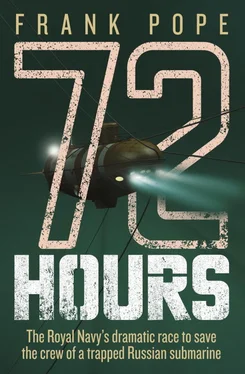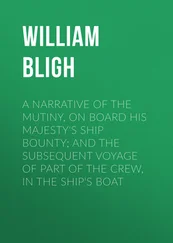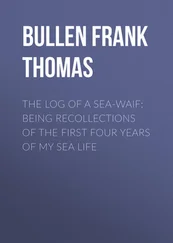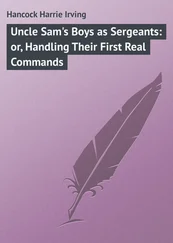Sillet had found no major leak. The pressure on the seabed – more than 20 tons per square metre – must have forced some of the oil back up the umbilical. It was a fairly common problem, especially if the vehicle hadn’t been deep for a while. He powered the hydraulics up to full pressure and could see no sign of a drip. There would have to be a major leak to empty the newly filled reservoir in the few hours they’d need to remain on the site, so he stepped back from Scorpio, his fix also finished.
Twenty minutes had passed, and Pine and Forrester were making the final twists to the bolts holding the new cutter guide on to the cutter arm. At 14.30 they too stepped away from Scorpio and Nuttall turned on the power once more, flashed the lights and spun the thrusters. Everything worked. Sillet lifted the vehicle back up off the deck and at 14.35 it was back in the water, heading back to the array and to the seven men still trapped against it.
The Russians were smiling again. Unbeknown to the UK rescue team, someone aboard the command ship took Scorpio’s return to the water as evidence that the rescue was now certain, for the Georgy Kozmin carrying the American team and their Super-Scorpios was turned back to port. The online ISMERLO forum of submarine rescue experts erupted in horror, for the safety net of the backup system had just been removed. Admiral Roughead put in an urgent call to Vice-Admiral Avdoshin, but all his calls for the American team to be allowed to continue to the site were refused.
On KIL-27 , the team knew only too well that the rescue was not over yet. Scorpio might be back in the water, but they still had a job to finish.
Sunday, 7 August
SS + 70 h 35 mins
03.05 UK – 06.05 Moscow – 15.05 Kamchatka
KIL-27 , Berezovya Bay
Nuttall was more comfortable approaching AS-28 second time around. The bulk of the array on the sonar didn’t unsettle him, but beckoned him instead. He felt refreshed after the break from the screen, ready to finish the cutting. But as Scorpio crested the array and looped over to examine the remaining bonds keeping AS-28 lashed to the apparatus, his heart started to sink. He couldn’t see anything substantial holding the submersible there, yet it was still there, unmoving. Why hadn’t the submersible tried to shift? He was getting a bad feeling about this. Looking at the remaining cables, he wasn’t sure how many more he was going to be able to cut.
He manoeuvred Scorpio in close to the striped hull. The front-camera monitor was now flashing into colour every so often, showing the stripes to be a deep red. The upper surfaces of the craft were now littered with the debris of barnacles scraped off the floatation chamber of the array by Scorpio’s movements.
‘Another turn of slack there, Will,’ he said into the mike. ‘Getting tugged around a bit. That swell picking up out there?’
‘More slack coming. Will keep an eye on it,’ came Forrester’s reply.
The most exposed part of the fifth cable was between the fin of the submarine and the array, but the gap was too small for Scorpio to reach it properly. Nuttall was trying to approach at a skewed angle to get in tighter, but it was difficult piloting. Gold was still against the wall, his left arm held out in front of him gripping the manipulator master arm. He was intently focused on the screen over Nuttall’s shoulder, face screwed up with the strain and his arm hunching and lunging as he tried to grab at the line in the water. Holding it in such an awkward position was making his muscles burn. He could feel beads of sweat starting to trickle down his spine.
At last he snapped the claws shut. An agonising fraction of a second later he saw the jaws respond, the rope caught in their grip. Slowly he fed it across into the newly replaced guide. Nuttall reached across and flicked the switch for the cutter, jabbing it forward to engage it before snapping it back. Nothing seemed to move until a few strands sprang back from the cut. But the main body of the rope remained taut. The line was still intact. It hadn’t been deep enough into the cutter’s mouth to be fully severed.
Gold tried jiggling the arm to push the cable in deeper.
‘Try that,’ he said.
Nuttall flicked the switch once more, but still the blade couldn’t reach the meat of the rope. Something was preventing him for getting any closer.
‘I can’t get in there. I think the skids are getting in the way,’ said Nuttall.
‘Try changing the angle a little? If we can just get around a little…’ said Gold.
But nothing was working. Gold’s frustration was mounting as he adjusted the position of his arm to try to get the cable into the cutter, but the space was just too tight.
Eventually, at about 15.30, they gave up. They had to try something else. With Scorpio retreated from the close quarters at which she’d been for the last 20 minutes or more, they could see AS-28 was swaying in the current. She had to be loose, they told each other. It seemed obvious.
‘She’s got to blow her tanks,’ said Gold. ‘It’s the only way.’
By releasing high pressure air into her ballast tanks from her air reserves the submersible would become positively buoyant. The motion should pull her free from the few remaining bonds, as long as they weren’t substantial enough to keep her there. They had to risk it. The downside was that they knew she had already blown her tanks at least once to no avail. This blow would probably be her final chance of reaching the surface.
Podkapayev would have none of it when Riches explained their thoughts. He was shaking his head violently before the translator was even halfway through explaining. He demanded that Scorpio be driven underneath AS-28 and up her starboard side as far as it could go to make sure the submersible was entirely clear.
‘I can’t do that,’ said Gold. ‘Taking a look underneath that submersible means our umbilical will be looped right round her. If anything happens and we get stuck, then those guys are trapped down there much more securely than they were by those nets.’
Riches agreed. But Podkapayev was looking very uncomfortable. Was there something he wasn’t telling them? As far as the UK team knew the ballast air was separate from the main supply, but their knowledge of the detailed workings of the Russian submersible was limited. It was perfectly possible that the ballast air also supplied the main crew chambers. In that case, blowing the tanks would substantially reduce the life expectancy of those on board.
‘We can’t do it Dmitriy,’ Riches said. ‘It’s too dangerous to go underneath. We know how quickly things can go wrong, and if they do then we’re suddenly back to square one, but this time without any time to solve it.’
‘We cannot blow the tanks. You must cut all lines,’ came the stubborn reply.
‘She’s loose. You can see it,’ urged Gold.
‘If she is not free when she blows she can lose her balance and go on her side. We cannot,’ said Dmitriy. Depending on where on the AS-28 the cable was still attached, it could tip the craft at a dangerous angle. Such a sudden change could easily cause something unexpected.
‘That’s a risk we’re going to have to take,’ said Gold. ‘We’ve run out of time, and out of options.’
Eventually, Podkapayev left the cabin to discuss the situation with his commanders on the Alagez over the radio. Agonising minutes passed before he returned, declaring that the Russians wanted an alternative plan. Gold and Riches had already discussed the possibility of using one of the lifting eyes they’d seen on AS-28 ’s hull. On training operations Scorpio was often sent to retrieve dummy mines for the Navy by dropping lines on to them so they could be hauled up on deck. There was plenty of steel cable available on the ship; AS-28 could be pulled free using one or two of the small tugs. If AS-28 ’s ballast tanks were full of air, her positive buoyancy would cause her rise to the surface. If not, the cable could be reeled in to bring her up. It wasn’t ideal because the craft might come up at an awkward angle, with all the problems that entailed, but at least it would get them to the surface.
Читать дальше












